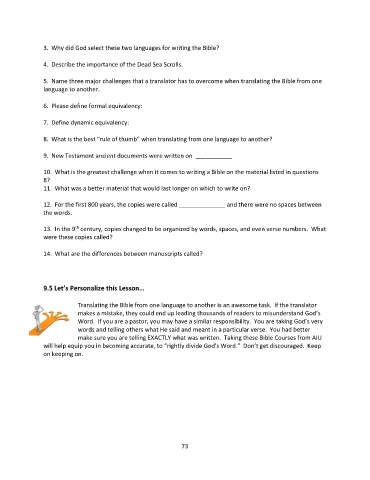Page 74 - Doctrine and History of the Preservation of the Bible Student Textbook
P. 74
3. Why did God select these two languages for writing the Bible?
4. Describe the importance of the Dead Sea Scrolls.
5. Name three major challenges that a translator has to overcome when translating the Bible from one
language to another.
6. Please define formal equivalency:
7. Define dynamic equivalency:
8. What is the best “rule of thumb” when translating from one language to another?
9. New Testament ancient documents were written on ___________
10. What is the greatest challenge when it comes to writing a Bible on the material listed in questions
8?
11. What was a better material that would last longer on which to write on?
12. For the first 800 years, the copies were called ______________ and there were no spaces between
the words.
th
13. In the 9 century, copies changed to be organized by words, spaces, and even verse numbers. What
were these copies called?
14. What are the differences between manuscripts called?
9.5 Let’s Personalize this Lesson…
Translating the Bible from one language to another is an awesome task. If the translator
makes a mistake, they could end up leading thousands of readers to misunderstand God’s
Word. If you are a pastor, you may have a similar responsibility. You are taking God’s very
words and telling others what He said and meant in a particular verse. You had better
make sure you are telling EXACTLY what was written. Taking these Bible Courses from AIU
will help equip you in becoming accurate, to “rightly divide God’s Word.” Don’t get discouraged. Keep
on keeping on.
73

